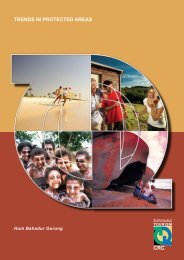icolls - Sustainable Tourism CRC
icolls - Sustainable Tourism CRC
icolls - Sustainable Tourism CRC
Create successful ePaper yourself
Turn your PDF publications into a flip-book with our unique Google optimized e-Paper software.
ECOLOGY, THREATS AND MANAGEMENT OPTIONS FOR SMALL ESTUARIES AND ICOLLS<br />
event was short lived and lagoonal sedimentation resumed soon after deposition. The late Holocene age of the<br />
sand sheet along with the lack of associated beach deposits and evidence of wave scouring suggest that a higher<br />
sea level hypothesis is unlikely. This deposit is probably the result of rapid high-energy oceanic inundation from<br />
the southeast. The study of washover deposits is often complicated by interpretation, as there is a significant grey<br />
area between deposits attributed to tsunami or storm. We conclude that the sand deposit is the product of a shortlived,<br />
large-scale overwash event attributed to a possible late-Holocene tsunami or exceptionally large storm<br />
event.<br />
Title of paper: <strong>Sustainable</strong> Management of Intermittently Closed and Open Lakes and Lagoons (ICOLLs):<br />
Knowledge Gaps and Threatening Processes<br />
Author: Angela Arthington and Wade Hadwen<br />
Author's email: a.arthington@griffith.edu.au<br />
Abstract: <strong>Sustainable</strong> management of ICOLLS is currently hampered by our lack of understanding of the key<br />
processes that maintain these complex ecosystems. Whilst data from permanently open estuarine systems is<br />
likely to be somewhat applicable to ICOLLs, the unique and highly variable physical, chemical and biological<br />
characteristics of these systems suggest that the processes that drive ICOLLs may be somewhat different. To<br />
date, very little research has attempted to determine the ecological structure and functioning of ICOLLs and their<br />
responses to natural and anthropogenic perturbations. Fish faunal surveys dominate the otherwise scant<br />
literature, owing to the numerous commercially valuable species that inhabit these coastal waterways. At present,<br />
there is a lack of integrated research investigating the major processes threatening the ecological sustainability of<br />
ICOLLs. We suggest that the major threatening processes are: eutrophication, contamination, fish extraction,<br />
modification of flow and opening and closing regimes, tourism/recreational use, and coastal development. The<br />
status of ICOLLs in relation to increasing coastal development is of concern, particularly with regard to artificial<br />
opening regimes, STP inputs and excessive runoff from industrial, urban and agricultural land uses. These<br />
human influences undoubtedly threaten the long-term sustainability of ICOLLs and the species that inhabit them.<br />
This paper will highlight areas of research required to strengthen our understanding of ICOLL ecosystems, and<br />
the role they play in sustaining biodiversity, ecological function and fisheries production in the coastal zone.<br />
Title of paper: Contributions of jellyfish to nutrient regeneration in coastal lagoons<br />
Author: Kylie Pitt, Klaus Koop & David Rissik<br />
Author's email: K.Pitt@griffith.edu.au<br />
Abstract: Scyphozoan jellyfish abound in coastal lagoons of New South Wales and at times their biomass can<br />
exceed 500 tonnes km-1. The rhizostomes Catostylus mosaicus and Phyllorhiza punctata are the most common<br />
species. Both species contain symbiotic zooxanthellae but concentrations appear to be much greater in P.<br />
punctata. Our experiment measured the rates at which NH3, PO4 and NOX were taken up or excreted by each<br />
species and in two controls: a “water only” control and a “mucus” control. Experiments were repeated twice<br />
during the day and twice at night and were conducted under both ambient and enriched nutrient conditions. P.<br />
punctata excreted small concentrations of NH3 under ambient nutrient conditions (average 37 mg kg-1 WW hr-<br />
1) but under enriched conditions excreted NH3 during the night (49 mg kg-1 WW hr-1) and took up NH3 during<br />
the day (123 mg kg-1 WW hr-1). In contrast, C. mosaicus excreted NH3 at a rate of 1505 mg kg-1 WW hr-1<br />
during the day and 1016 mg kg-1 WW hr-1 during the night. P. punctata neither took up nor excreted PO4 but<br />
C. mosaicus excreted PO4 at a faster rate during the day than night (173 cf 104 mg kg-1 WW hr-1). Both C.<br />
mosaicus and P. punctata excreted NOX and, although the rate of excretion for P. punctata varied between the<br />
two experiments conducted during the day, the rate of excretion was consistently greater than for C. mosaicus<br />
(52 and 80mg kg-1 WW hr-1 cf 26 mg kg-1 WW hr-1). The contribution of P. punctata to nutrient regeneration<br />
appears to be small but during times of population blooms, excretion of NH3 by C. mosaicus may meet up to 8%<br />
of the NH3 required by phytoplankton<br />
Title of paper: Aspects of the Quaternary Geomorphology of the Belongil Swamp, Byron Bay, New South<br />
Wales, Australia.<br />
Author: Mitchell Tulau<br />
Author's email: Mitch.Tulau@dipnr.nsw.gov.au<br />
Abstract: Geomorphic investigations have revealed aspects of the Quaternary geomorphic history of the<br />
Belongil Swamp, a back-barrier swamp at Byron Bay. High resolution elevation data with an elevation accuracy<br />
of +/- 25 mm was acquired at approximately 7500 sites by a 6WD all-terrain vehicle linked to GPS satellites.<br />
After post-processing of the data, high resolution contour plans were drafted using software applying a number<br />
of interpolation techniques and presented on a rectified aerial photo base. Detailed soil and stratigraphic<br />
investigations have also been carried out in the wetland and associated Quaternary deposits. Two cores dating to<br />
8710 +/- 50 years BP and yielding pollen and phytoliths have been recovered from near the West Byron STP.<br />
58











